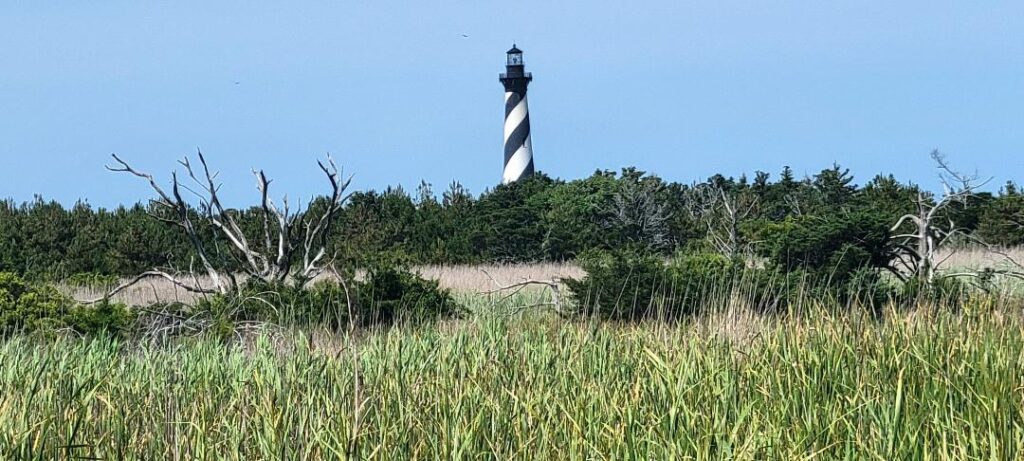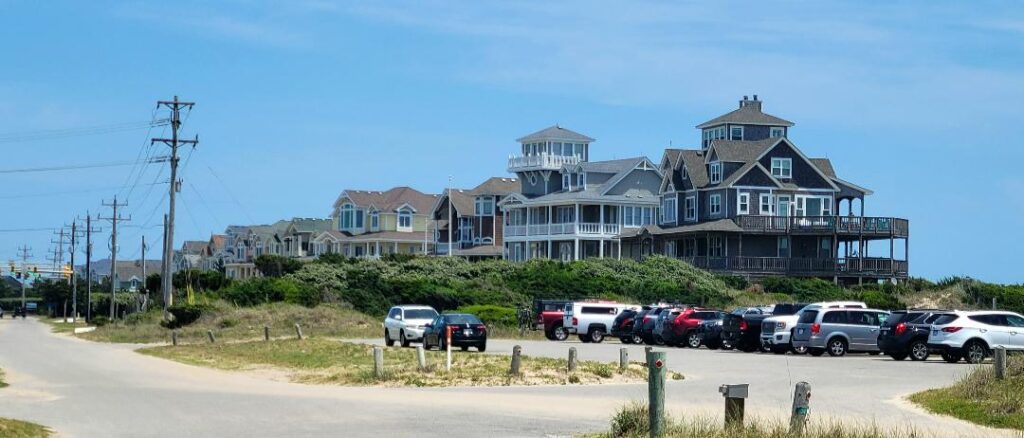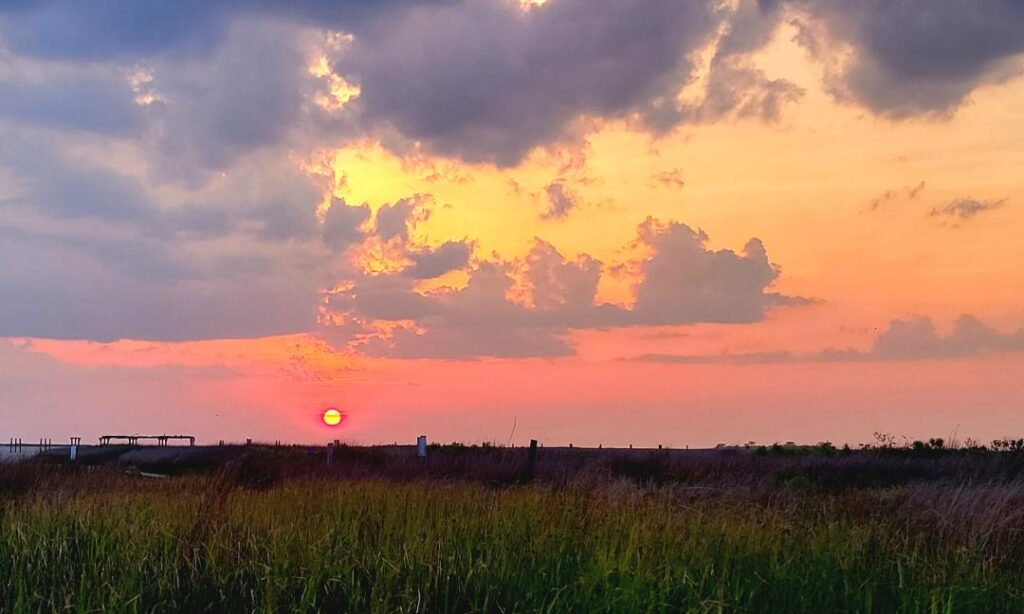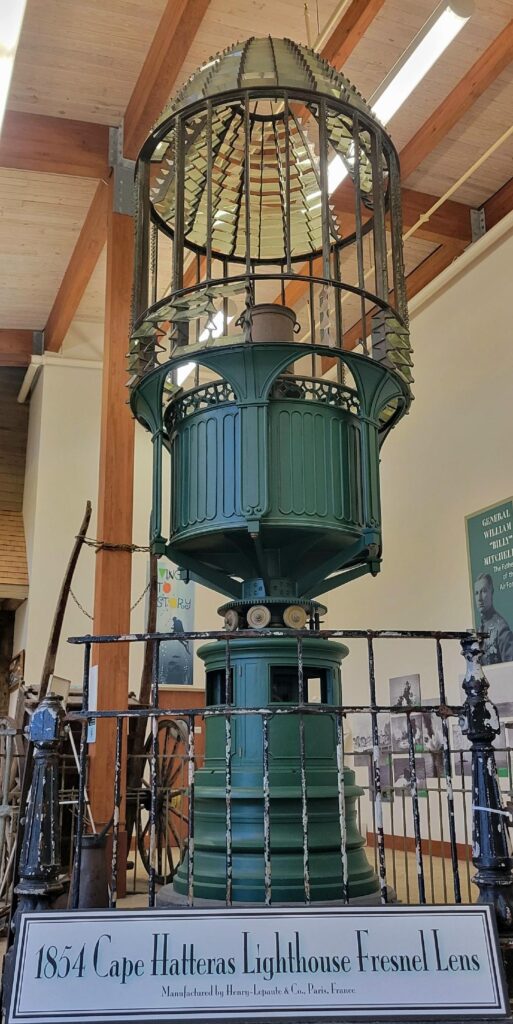
An impromptu trip to the Outer Banks, NC (OBX) while without a specific predetermined plan resulted in an exciting adventure full of surprises that stimulated my senses with views of expansive coastal landscapes, picture worthy sunsets, and amusing visual peculiarities. We drove to the barrier islands via Highway 64 crossing from Manns Harbor over the Virginia Dare Memorial Bridge to Roanoke Island and with one more island hop, we landed on a skinny strip of land. We turned right and proceeded south along Highway 12 which carelessly unfolded in front of us like a scrap of dirty grayish ribbon covered with piles of sand and occasionally submerged in puddles of brackish water from yesterday’s rain. Highway 12 loosely lays in a valley between majestic sand dunes overgrown with costal grasses, shrubbery, and flowers. The dunes obscure the view of the vastness beyond them and often hide the ocean behind their majestic powdery mass.
Protruding Water Towers
Scattered in the distance we could see individual water towers puncturing the landscape like well-used blue push pins stuck into a 3-D map indicating small burrows of humanity.

My favorite tower topped with a crown of cellphone antennas indicated the village of Chicamacomico with a set of seemingly random letters surrounding the official seal of the County of Dare (I dare anyone to say Chicamacomico five times fast).
These burrows, villages or towns (I am not sure how to classify them) are a mosaic of human stratum of class and wealth. Most of the houses in the OBX are built on tall pylons; from the distance they appear like wooden boxes placed upon skinny match sticks. During the hurricane season the extra elevation provided by the pylons protects residents and their possessions from the incoming storm waves hungrily pouring over the narrow strip of land attempting to swallow up the houses.
The houses, I promptly classified into three distinct architectural styles.
(1) Small one-story houses some of them cutesy, artsy and well taken care off but many appearing in need of tender love and care; they could use a fresh coat of paint and human attention around the property.
(2) Large three-story buildings without much character or color, their exteriors covered with gray cedar shingles reminiscent of driftwood. These houses tower over the area like worn-out scaly dragons, and just like dragons they add a dreary look to the windblown scrubby landscape.
(3) Large architecturally intricate houses painted in all sorts of pastel colors of pink, yellow, blue and green, with white decorative moldings, multistory balconies, and numerous white columns happily propping up outside façades. They look like houses for princesses and I hope that they belong to happy wealthy people who get to use and enjoy them more often than not.

I pondered that on the same street a knight could fight a scaly dragon and then walk over next door to liberate his princess from a peach-colored castle, settle in a one-story house and live happily ever after. This is how the mosaic of private homes in the OBX blends together into residential neighborhoods.
Magnificent Sunsets

As we proceeded along the gray ribbon of Highway 12, the sun was going down and the OBX greeted us with a spectacular sunset. The sky was full of puffy white clouds hanging up like giant, messy cotton balls which turned yellow then orange and finally shades of crimson. Warm colors were mixing together reflecting off the clouds performing a spectacle, a fabulous show for the tourists. We stopped on the side of the road with a few other travelers and took pictures of the dynamic images in front of us until the red hot disk plunged into the wavy waters of the Pamlico Sound, signaling to the weary travelers to return to our cars and continue on our journeys, some went north and others including us continued down south. As we drove along a long-curved bridge, we noticed another solid concrete viaduct under construction towering over the Sound. Once this viaduct becomes operational OBX’s ecology and integrity of the sand dunes might benefit and the Department of Transportation might be happy with lower maintenance costs but it will be an eye sore. The people who invested money into properties hoping for undisturbed views of the Pamlico Sound and the colorful sunsets, soon will look onto a steadily stream of traffic moving across the concrete corridor known as Highway 12. The revised landscape will not come close to what was promised to the eager buyers by real-estate agents eager to make a buck.
Having suffered a painful ordeal of a broken left wrist, my trip to the OBX was different in nature than I would like to experience. There would be no water sports for me, no cycling, nothing that requires the full use of two hands such tying shoelaces or twisting my hair into a ponytail. I was relegated to experience the weekend as an average, middle aged, unaccompanied female tourist. While my friends and the love of my life were learning to wing foil, I hoped to spend my days hanging out in coffee shops, writing, taking long walks on the beach, indulging in short jogs and as the high point of my trip ferrying across the Sound from Hatteras to Ocracoke. There are two ferries running from Hatteras to Ocracoke. The car ferry docks in Ocracoke about 12 miles from the village center; it runs every thirty minutes and is free. There is also a walk-on ferry that runs three times per day, costs five dollars and docks right at the Ocracoke village center, a short walk from the lighthouse, bars, restaurants and the British cemetery.
At 9:45 AM and with great excitement I arrived at the Hatteras Ferry Terminal, parked my car and proceeded on foot to guest services. A smiling uniformed lady eagerly slid open a small glass panel in the ticketing window and informed me that the walk-on ferry departed about fifteen minutes ago but there is another walk-on ferry leaving at 1:00 PM. I decided to get back into my car and line up for the car ferry which should depart in about fifteen minutes.
Time passed, cars in the lanes left of me moved forward, I started my engine ready to move but there was no forward motion by cars in my lane. In the distance, I could see the American flag on the mast of the ferry flattering in the wind and disappearing into the distance. I stepped out and approached the car in front of me, from the driver I learned that each ferry takes between 25 and 35 cars depending on the size and all the vehicles in our lane need to wait thirty more minutes for the next ferry. Sitting in the car and waiting for the next ferry was not my idea of how I would like to spend this day in the OBX. I got back into my car, made a u-turn and went back to the ferry parking lot. I proceeded to the ticketing window where the nice uniformed lady once again greeted me with a pleasant smile and I purchased a 9:00 AM ticket for the next day’s walk-on ferry. With my plan solid for the next day, I drove a little over 75 feet to the parking lot for the Graveyard of the Atlantic Museum.
Story of 1854 Cape Hatteras Lighthouse Fresnel Lens

A young lady at the front desk informed me that admission to the museum is free but donations are welcomed, five dollars was suggested. The most impressive exhibit highlighted for visitors is the Fresnel Lens, historically lighting up the ocean skies from the top of Cape Hatteras Lighthouse, albeit maybe not so successfully otherwise why is this place called the Graveyard of the Atlantic (this you can learn by watching a seven-minute film in the museum’s auditorium). The Fresnel Lens has a mystery associated with it. The lens was built in 1853 by a French manufacturer and purchased by the US government to reduce the number of shipwrecks in the surrounding waters; it was placed on the top of the original Cape Hatteras Lighthouse. The artifact is composed of 6000 pounds of copper and crystal lenses. I stood there looking up trying to understand the shape of the individual crystal lenses. Looking from one angle they appeared like a honeycomb of triangular prisms but from another angle they seemed like numerous rectangular panels. The Fresnel Lens faithfully served as a working lens for many years, survived storms and earthquakes, was hidden during the civil war and sought after, damaged and restored, reinstalled, removed, its crystals were plundered by treasure hunters and then the contraption disappeared for many years. In 2002, Kevin Duffus from Raleigh, NC rediscovered the Cape Hatteras
Lens in an abandoned Little Kinnakeet Lifesaving Station near Avon, NC. Currently the Cape Hatteras Lighthouse original Fresnel Lens is on a display at the Graveyard of the Atlantic Museum for all of us to see and marvel upon.
Story of Jobell Flower

Driving down Highway 12, I could see carpets of yellow and red flowers; they were so visually appealing that I decided to stop the car and smell them. I can report that they do not have an aroma but they certainly appear resilient to the harsh island elements growing in sand, between rocks, and in the most inhospitable conditions providing so much brightness and color to the environment. Appreciating vibrant petals and flamboyant centers of the showy flowers, I was reminded of the prior day’s sunset. On a much smaller scale the powerful yellow, fiery red, and warm orange heads were glowing and staring back at me just as the sun did the day before. Apparently, these flowers properly named Gaillardia are not native to the OBX. I did not bother to investigate the scientific way how these flowers made their way to the barrier islands, I preferred to hear folk stories of their elaborate origins. There was a man named Joe Bell and a lady named Josephine. The two married and enjoyed extended vacations to the barrier islands. They were genuinely good people, offering their precious time and vast knowledge, lending helpful hands, and sharing joy and good will.

Josephine fell ill and died, Joe was sad and no longer enjoyed spending time in the OBX without Josephine. One day when working in his garden on the mainland, Joe noticed beautiful red and yellow flowers sprouting in his garden ala immaculate conception. He gently dug up the flowers, went to the OBX and gingerly planted them in the dunes. The flowers took to the local conditions; every year Joe collected seeds and continued planting more and more Gaillardias just like Johnny Appleseed; hence forth Gaillardia in the OBX is known as Joebell flower. Upon closer inspection I noticed two different varieties of Gaillardias. I believe they are Arizona Sun and Fanfare. At the day’s end, I drove back to the house generously lent to us by a dear friend, my eyes feasted on the OBX landscape and Joebells gently waved their colorful heads in the evening breeze.



Apparently your hours of inactivity spent writing were well-spent !! This post is a very enjoyable read ,Irena. Thanks .
Thank you, one needs to occupy herself somehow and I had many hours for re-reads and re-writes and Erik helped, too.